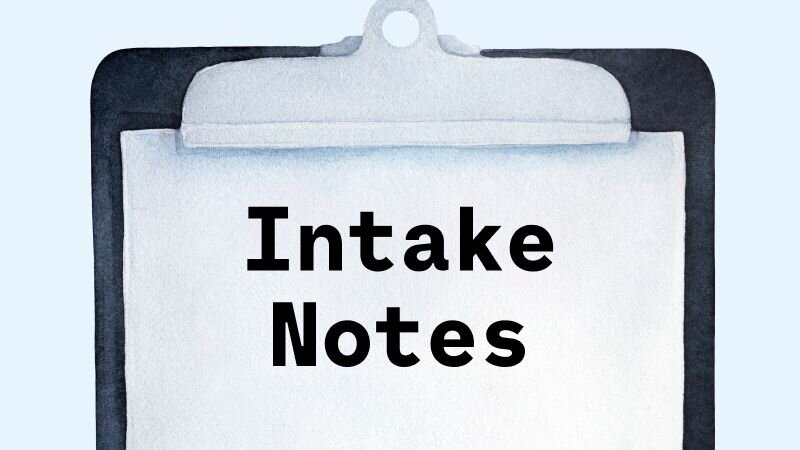
5 popular types of progress notes for therapists
Learn about how to write SOAP notes, DAP notes, BIRP notes, and more therapy notes.

The intake assessment is your chance to get a deep understanding of your patient — and maybe connect some elements from their journey that they wouldn’t connect themselves.
“Intake assessments” might be the wrong name for such an important piece of clinical documentation. They’re not just for intake — they document the evidence that helped you come to a diagnosis and develop a treatment plan.
When you're meeting a client for the first time, you’ll need a diagnostic session to understand their background and presenting problems. But you might also want to conduct another assessment some time later if your client’s situation seems very different from where you started. (Insurance payers will typically only reimburse intake sessions once per year.)
“I conducted new intake assessments with some of my patients in 2020 a few months into the pandemic lockdown,” says Innocent Turner, Clinical Strategy and Quality Manager at Headway. “Their symptoms were different from what we’d talked about in our first session together, and different from the diagnosis we were initially working through.”
Providers tend to have the fewest questions about intake assessments — they’re one of the most structured and defined parts of clinical documentation. Insurance carriers, however, still want to see a certain level of care and attention has been given to your first session with a new client. Here’s what you need to know.
Your intake assessment fulfills an important role as a starting point for your relationship with a client.
It’s how you, as a mental healthcare provider, can begin to understand the current state of your client’s mental health, including:
The intake assessment is also your opportunity as a provider to get a sense of your client’s overall health, including their full background of medical conditions, medications, and allergies. It all helps to paint a more detailed picture of your patient in the event of a mental health crisis.
Many providers call the intake assessment the “bio-psycho-social assessment,” which functions like a shorthand for the key points you need to address with your client: their biological history, their psychological history, and their social history.
Intake assessments billed with 90791 or 90792 CPT codes have no documented time requirement. Typically, an intake session lasts 45-60 minutes, by most clinical standards, due to the complexity of conducting a full assessment.
Intake assessments are typically completed once per year, per client.
While there are many options for documentation, Headway's in-product templates are designed to make note-taking fast and efficient, all while helping to take out the guesswork.
Plus, our templates are included at no additional cost for Headway providers.
Headway’s team and tools are here to make everything about working with insurance companies (including compliance!) as easy as possible.
A complete patient chart contains three core pieces of clinical documentation: an intake assessment, treatment plan, and progress notes.
Think of these as the “golden thread”: Your intake note should inform your treatment plan, and your treatment plan goals and objectives should be reflected in each progress note. Whereas progress notes must be completed after each session and treatment plans may be adjusted over time, intake assessments are generally taken at the beginning of a therapeutic relationship and repeated only if the client’s situation changes dramatically or a significant amount of time has passed.
Here are the key details of the different types of documentation:
1. An intake assessment (intake note) should be created when initiating a treatment relationship with a client, and serve to document their current state and past experiences with mental healthcare.
2. A treatment plan establishes objectives and monitors progress. The plan includes a diagnosis and clearly establishes medical necessity for treatment.
3. Progress notes should demonstrate a clear and comprehensive story of the client’s progress through treatment. Clear continuity of care is important — each note should lead into the next but also stand alone.
Clinical documentation is a staple of any mental healthcare practice — it’s used to clarify the purpose of your sessions, justify the billing code used, and demonstrate a good picture of the patient’s current mental state.
These standards are outlined by the American Medical Association (AMA), Centers for Medicare and Medicaid Services (CMS), National Committee for Quality Assurance (NCQA), commercial insurers, and other regulatory agencies.
Your license or a particular insurer may have even stricter requirements than those set forth here.
In order to fulfill the needs of insurance carriers, it’s important that your intake assessment notes contain the following requirements and essential information:
These easy-to-note facts are required for all documentation, including your intake assessment:
For the intake note, you need to capture what caused the client to seek help and why now. This is the history of present illness (HPI), or sometimes called a “chief complaint” or “presenting problem.” It’s important to accurately capture the HPI in your intake assessment, as it will inform your diagnosis and treatment plan moving forward and is among the elements insurance carriers will expect to see.
An HPI or chief complaint might look something like this: “The client presents for initial assessment due to increasing feelings of anxiety and depression over the last six months, following a job loss and financial stress. Client reports persistent feelings of sadness, low energy, and difficulty concentrating, which disrupt social life and daily functioning. Client also reports frequent worry and physical symptoms, including muscle tension and headaches.”
Your intake note should contain detailed patient background information. This includes a full medical (biological), behavioral, and social history for the patient. This is what makes it an intake note: You’re understanding the patient’s background before they started working with you.
This part of your intake note might include:
You should document your mental status examination of the patient’s behavioral and cognitive functioning. This might include descriptions of the patient’s appearance, behavior, alertness, reasoning, or mood.
In order to provide the best care possible, you need to document the client’s risk of doing harm to themselves or others. The Suicide Prevention Resource Center’s list of key risk and protective factors can help guide your assessment.
The plan in the intake assessment is the clinical plan. In other words: What you, as a provider, feel is the best path forward from here. This may include your intent to complete a treatment plan in your next session.
Here’s an example of an intake note that meets most insurance carriers’ compliance expectations for this type of clinical documentation.
Notice how it contains all 6 of the primary requirements for a compliant note.
Client Full Name: Katie Client
Client Date of Birth: 9/9/1999
Date of Service: 3/08/2023
Exact start time and end time: 10:23am-11:20am: 57 mins
Session Location: Telehealth, patient provided consent to telehealth, service performed on HIPAA compliant software
Diagnoses:
Major Depressive Disorder, Moderate, Single episode. Chief Complaint: Katie presents to initial session with report of worsening depression over the last month. Informs therapist she was previously diagnosed in 2019, has been to therapy in the past and finds it helpful. Says she was doing well until she lost her job 3 months ago. Once she found a new job her boyfriend ended their relationship
Chief Complaint:
Patient reports difficulty falling asleep, difficulty staying asleep, depressed mood 5/7 days, denies impulsivity denies eating concerns/issues, denies avh, endorses somatic symptoms of headaches, reports "some" childhood trauma
History:
Mental Status Exam:
Risk Assessment:
Assessment:
Katie presents with symptoms consistent with mood disorder, she describes her overall mood as "I have nothing to look forward to," "I feel bad for existing," and "i randomly feel like i have a lump in my throat." Described mood consistent with DSM-5 criteria for Major depressive disorder of worthlessness, feelings of guilt, she endorses sleep disturbance of difficulty falling asleep, low energy/fatigue and difficulty concentrating. Therapist helped Katie process her feelings, provided in depth psychoeducation on depression overall, and relevant symptoms that she is experiencing such as guilt and low energy.
Plan:
Therapist will utilize both motivational interviewing and CBT-Depression to help Katie learn coping skills to manage depression symptoms specifically feelings of guilt. Therapist recommends weekly sessions, Katie is in agreement with this. Next session, therapist and Katie will complete the treatment plan.
Electronically signed by: Susan Practitioner, LCSW
Note signed date: 3/08/2023
This document is intended for educational purposes only. Examples are for purposes of illustration only. It is designed to facilitate compliance with payer requirements and applicable law, but please note that the applicable laws and requirements vary from payer to payer and state to state. Please check with your legal counsel or state licensing board for specific requirements.
Writing a thorough and complete intake note takes some practice. As you get started, remember to:
Intake appointments can cover a lot of ground. Distilling such a wide-ranging discussion into a succinct yet thorough note can be challenging, although templates like Headway’s make the process much easier. When writing intake assessments, try to avoid these common pitfalls:
Once you’re sure your intake note documentation fulfills the expectations of the insurance carrier, you can use the CPT code 90791 or 90792 to bill for your services, depending on your license type.
It’s important to use the code that most accurately reflects the time you spent with the patient to treat their condition, and ensure that documentation for the session supports the chosen code.
Documentation of relevant aspects of client care, including documentation of medical necessity, should ideally be completed within 24 hours of visit, and no later than 72 hours.
The 90791 CPT code refers to a service where the provider performs a psychiatric diagnostic evaluation of the patient with the aim of making a diagnosis. Code 90791 is used by psychologists, social workers and other licensed behavioral health professionals.
This code should only be used once per year per client, unless otherwise clinically necessary.
The 90792 CPT code refers to a service where the provider performs a psychiatric diagnostic evaluation of the patient with the aim of making a diagnosis. Code 90792 is used by psychiatrists and psychiatric nurse practitioners and physician assistants, because it includes medical services.
Similar to the talk therapy code above, the 90792 code should only be used once per year per client, unless otherwise clinically necessary.
While there are many options for documentation, Headway's in-product templates are designed to make note-taking fast and efficient, all while helping to take out the guesswork.
Plus, our templates are included at no additional cost for Headway providers.
Headway’s team and tools are here to make everything about working with insurance companies (including compliance!) as easy as possible.

Learn about how to write SOAP notes, DAP notes, BIRP notes, and more therapy notes.

Here’s how to decide which progress note-taking style is right for you.

GIRP notes are a format for therapy progress notes. These examples can help you effectively document your work as a clinician.